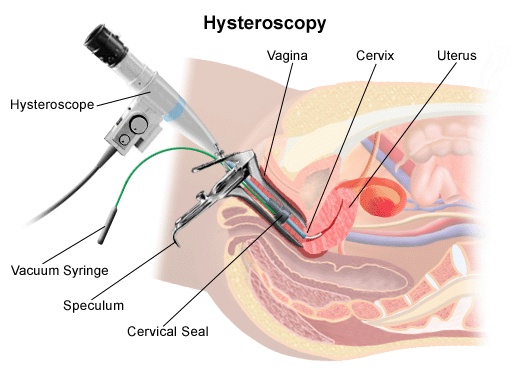
Hysteroscopy is the process of using a viewing scope to examine the interior of the uterus along with the cervical canal. The scope is inserted through the vagina and into the cervical opening. The procedure can be performed as an aid in the diagnosis of problems with the uterus, or it may be combined with simple surgical techniques for treatment purposes.
Hysteroscopy is a day-care procedure and needs no hospitalization overnight. The diagnostic power is higher than other methods because possible problems can directly be visualised in the uterine cavity. It is a very important method in infertility investigations, recurrent pregnancy losses, and abnormal uterus bleeding. A sample can be collected to make a diagnosis in endometrial pathologies. Hysteroscopy may be used to both diagnose and treat specific conditions of the uterine cavity.
Common problems that can be treated by hysteroscopy include:
- Diagnosing and treating abnormal uterine bleeding
- Investigation of infertility
- The treatment of scar tissue in the uterus (Asherman syndrome)
- Removal of fibroids or polyps
- Endometrial ablation (a treatment where the uterine lining is removed due to heavy periods)
- Treatment of uterine abnormalities
Procedures done
- Diagnostic hysteroscopy
- Operative hysteroscopy:
- Targeted biopsies
- Removal of endometrial polyps and submucous leiomyomas
- Resection of uterine septa
- Removal of “lost” IUDs and other foreign bodies
- Lysis of intrauterine adhesions
- Tubal cannulation (tubal obstruction)
Operative Hysteroscopy
Therapeutic applications of hysteroscopy
- Targeted biopsies – Biopsy of an abnormal endometrial lesion is essential, particularly a lesion suspected to be malignant or premalignant. Hysteroscopy offers the possibility of choosing the area in need of biopsy.
- Removal of endometrial polyps and submucous leiomyomas – Endometrial polyps are benign growths appearing to originate from localized hyperplasia of the endometrium. They usually present as abnormal uterine bleeding, but are also implicated as a possible cause of infertility. Hysteroscopic polypectomy is a minimally invasive operation and allows complete removal of polyps under direct vision.Uterine myomas/ fibroids are benign encapsulated tumors that originate from the muscle tissue of the uterus. hysteroscopic surgery offers a therapeutic alternative to that radical approach.
- Resection of uterine septa – Uterine anomalies, specifically uterine septum, may cause repetitive abortions. Hysteroscopic treatment provides a less invasive approach to divide the uterine septum. The treatment offers minimal discomfort to the patient as well as minimal morbidity. Different methods can be used to divide the uterine septum. The mechanical method using rigid scissors, the resectoscope, and the fiberoptic laser.
- Removal of “lost” IUDs and other foreign bodies – Hysteroscopy is the best method of removing partially embedded or fragmented intrauterine devices (IUDs) misplaced within the uterine cavity. Removal of these devices under visual control prevents unnecessary trauma to the uterus by blind manipulations and permits visual appraisal of the condition of the device regarding embedment or fragmentation.
- Lysis of intrauterine adhesions – Adhesions form between the anterior and posterior walls of the uterus as a result of trauma and Classically, this problem follows abortion or post partum hemorrhage for which a vigorous curettage was performed. Hysteroscopy is the standard method for treatment of intrauterine adhesions; it allows for selective division of adhesions without damaging the surrounding healthy endometrium and offers an excellent alternative to reestablish the symmetry and architecture of the uterine cavity. The use of semirigid hysteroscopic scissors has improved lysis of adhesions.
- Tubal cannulation (tubal obstruction) – Proximal obstruction of the fallopian tubes occurs in about 10% to 20% of women who undergo hysterosalpingography as part of their infertility evaluation. Proximal fallopian tube obstruction is confirmed by laparoscopy and is often associated with simple occlusion or obstruction by debris or proteinaceous material plugging the tubal lumen without fibrosis. Hysteroscopic tubal cannulation offers the advantage of guiding the catheter under direct vision and the results are promising.
